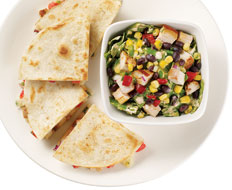The quick-serve industry has taken its share of blows from media and government alike as they suggest fast food is contributing to the nation’s obesity epidemic. And while the industry has risen to the challenge of offering lower-calorie, lower-sodium, and all-around healthier menu offerings, some still suggest that more could be done in the realm of portion sizing.
Even though shrinking the portion size of popular menu items may seem an easy response to the demands for healthier food, experts say the solution is not so simple.
Annica Kreider, vice president of marketing at McAlister’s Deli, sighs when she recalls testing smaller portion sizes of dishes with focus groups.
“They were attractive, people liked the way they looked, but they noticed the difference,” she says. “They didn’t want the items they loved in smaller sizes.”
Kreider says outright reducing portion sizes would not be a good idea for a brand.
“We have a strong following of loyal guests and they want what they want,” Kreider says. “Reducing portions is something that needs to be thought through very carefully to avoid alienating those core customers.”
Ted Stoner, head chef and director of strategic product development for Qdoba, says there is a regional component to portion sizes.
“In Manhattan, our customers are more interested in the quality, they’re not looking to get the biggest burrito in the store,” he says. “In other areas, they appreciate the quality but their first reaction is ‘Wow, look at the size of that burrito.’”
“In our industry, even as a quick-serve or fast-casual concept, we have to remember that eating out is an indulgence for people,” Kreider says. “Especially in today’s economy, with fewer discretionary dollars. If a customer comes to your place and feels somehow cheated out of the portion size, that’s the last time you’ll see them.”
Because of the differing consumer demand for portion sizes, brands are getting creative with their opportunities for smaller portions, suggesting the next big thing in portion size could be creativity.
The strategy at McAlister’s has been to focus on offering a Choose Two menu with a wide array of smaller-portion options.
“We point out plenty of 500-calorie Choose Two options, and we point out that if you’ve got to have that special sandwich and you’re trying to watch your weight, have a half with a bowl of vegetable soup instead of a full sandwich with a side of potato salad,” Kreider says. “It gives the customer control over their own portions.”
Qdoba’s approach to portion sizing is to give the customer a large degree of control. “People who are dieting often want to go a little easy on things like cheese, so the way we’re set up is perfect for them,” Stoner says.
“They have eye contact with the server and they can see how much cheese is put in and give a thumbs up when they feel it’s enough. So we’re letting them set their own portion sizes if they’d like less.”
Consumers also want choice when it comes to dining out, Stoner says. “You have different types of customers coming in together with different wants and needs,” he says. “If your restaurant only allows for high-calorie food choices, you’re not going to be around very long.”
Portion sizes at the Veggie Grill, a seven-outlet fast-casual chain in the Los Angeles area, can be described as “very healthy,” says Greg Dollarhyde, CEO of the company.
“Just by our name, people get a healthy feel for what we do,” he says. “They don’t feel bad about digging into our big cheeseburger, because it’s vegetarian.”
Dollarhyde says that in his view, healthy portioning by some chains is not productive in the long run.
“When you have an item that’s a big hit and you say, ‘Guess what? We’re going to use a little less beef and cheese on that burger to take the calories way down and it’s going to taste great,’ you’re not going to make many friends,” he says. “If people like what you gave them before, keep giving it to them. But offer an additional, lower-calorie menu item as a complement.”
Ian Gutierrez is a managing partner with OYE Cuban Grill, a mixed fast-casual and casual concept in Miami. He says that for new concepts like OYE, establishing appropriate portion sizes at the outset is important to set a customer’s expectations.
“We spend a lot of time on training to get the consistency down so that the sizes of everything are very close,” Gutierrez says. “When you’re a new concept, guests don’t know what to expect with the portions as far as size, nutrition, or value. You and your staff need to help.”
Operators like Gutierrez are trying to balance portion sizes with healthier offerings.
“We lean away from items like fried plantains and toward lean meats and roasted vegetables that give us a healthy brand,” Gutierrez says. “When you look at our platters, they’re full. Our steaks are 8 ounces, [but] you get a good portion of salad or veggies, and our customers say they like what they see.”
Much like Qdoba, OYE gives customers control over their meals. “You buy the filling and choose how you want it, which affects how it looks,” Gutierrez says.
“You can have it served in a rice bowl, in a salad, placed in a wrap, or served as a sandwich. These can vary your calories and also your perception of how much food you’re getting.”
Gutierrez says he pays attention to comments from customers, especially those who have tried competing fast casuals nearby.
“What I often here is that they’re not getting their money’s worth at the other guys, so they come back here,” he says. “While there’s pressure to have healthy options on the menu, your portion size better show some value.”









